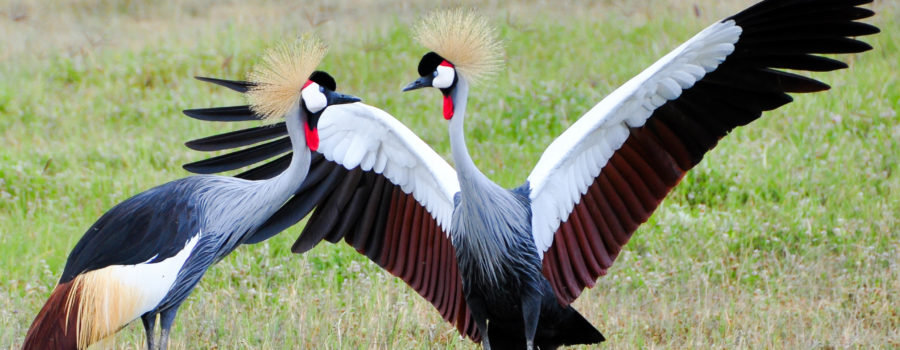The stunning “crown” that gives these birds their name is a key adaptation. This allows the cranes to blend in with the tall grasses, making avoiding predators and catching prey a much easier task. These birds are very tall, with slender legs and large feet adapted for spending a lot of time standing, wading, and walking. Their coloring is quite striking, with blue eyes in a white face framed by black feathers and a red wattle, light gray feathers below the head and down the neck, and dark gray or black on the flight feathers and top of the back. The rest of their wing is a light cream or white color, with bright yellow feathers near the base of the tail, and the tail itself is red to reddish-brown in color.
Diet: East African crowned cranes are omnivores, meaning their diet consists of both plants and animals. The tips of grasses, seeds, groundnuts, soybeans, maize, and millet are food sources that fulfill the plant matter of their diet. These cranes will also eat insects, other small invertebrates, and small mammals.
In the Wild: East African crowned cranes are not a migratory species of bird, but they may move around the local area depending on the abundance or distribution of food, available nest sites, and the amount of rainfall. Although they nest in pairs, they will roost communally at night in groups of up to 200 individuals. The cranes are dependent on their wetland habitat because this is where breeding and nesting occur.
Conservation issues/actions: The population of East African crowned cranes is currently decreasing due to loss of breeding habitat, unsustainable agricultural practices, and human interference in the form of snares or removing live cranes and their eggs from the wild. Accredited zoos like Reid Park Zoo are working together to conserve this species through managed breeding programs.
At the Zoo:
At the Reid Park Zoo, the East African crowned cranes are quite active. You may be fortunate enough to see their mating dance, which is very elaborate and includes head bobbing, wing flapping, and hopping in circles around each other. Our cranes are part of a Species Survival Plan (SSP) to support healthy populations of East African crowned cranes within zoos accredited by the Association of Zoos and Aquariums (AZA).

